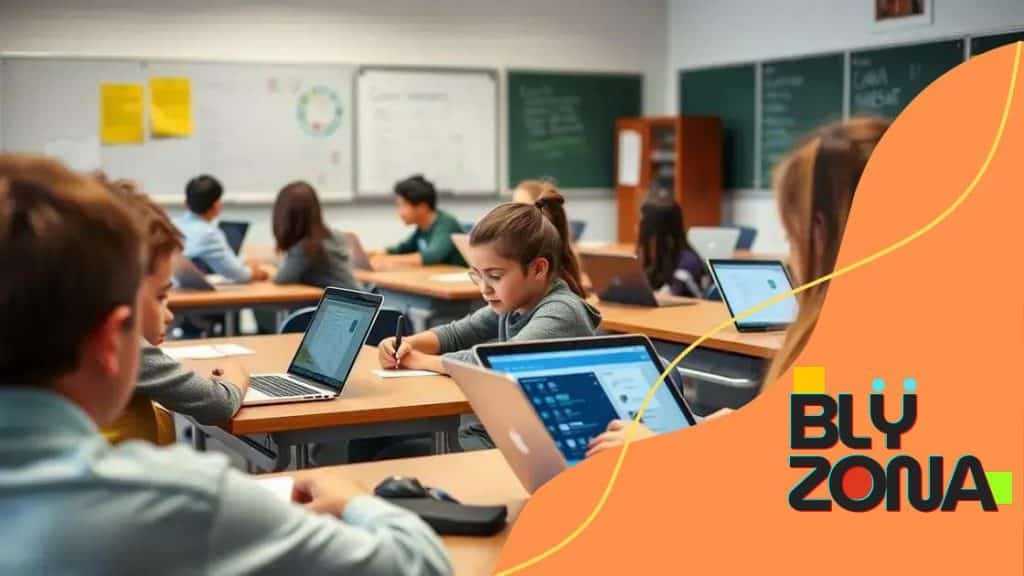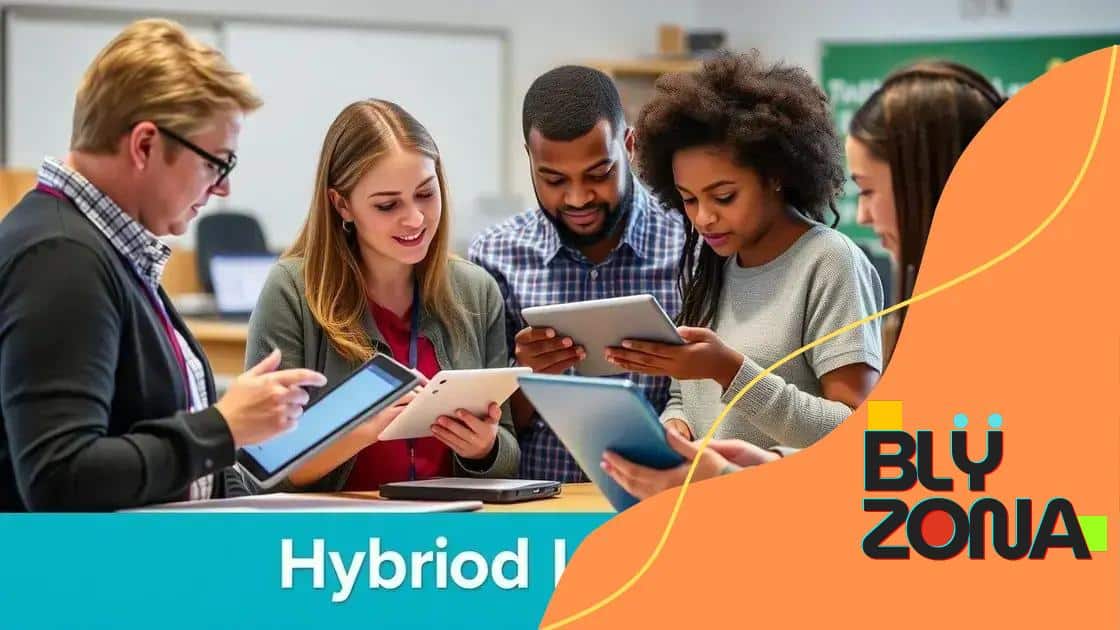Hybrid learning tools for higher education: Transform your study

Hybrid learning tools for higher education combine online and in-person experiences, enhancing flexibility, engagement, and personalized learning opportunities for students.
Are you curious about how hybrid learning tools for higher education can change the way we learn? They combine the best of online and in-person education, paving the way for a more flexible and engaging learning experience. Let’s dive into what these tools can offer.
Understanding hybrid learning tools
Understanding hybrid learning tools is essential for students and educators alike. These tools blend traditional classroom methods with modern online techniques, creating a versatile learning environment.
Hybrid learning offers many advantages. For instance, students can enjoy the flexibility of attending classes remotely while still engaging with their peers and instructors face-to-face.
Key Features of Hybrid Learning Tools
When exploring these tools, consider their main features:
- Accessibility: Students can access materials anytime, anywhere.
- Interactivity: Tools often include quizzes and forums to engage learners.
- Resource Sharing: Easy sharing of documents and presentations.
- Real-Time Feedback: Immediate response to student inquiries and progress.
Moreover, hybrid learning tools promote personalized learning experiences. With resources tailored to individual needs, students can learn at their own pace. This customization can make learning more effective and enjoyable.
As an example, online platforms can track a student’s progress and suggest next steps or resources based on their performance. This personalized support is vital in helping students master materials.
Popular Hybrid Learning Tools
Here are some popular hybrid learning tools that have demonstrated effectiveness:
- Learning Management Systems (LMS): Platforms that deliver and track education materials.
- Video Conferencing Tools: Essential for holding live classes or discussions.
- Interactive Learning Apps: Enhance engagement and collaboration among students.
Educators also benefit from these tools. They can easily monitor student progress and adapt their teaching styles to meet diverse needs. This adaptability is a key advantage of hybrid learning.
Lastly, using hybrid learning tools opens the door for more innovative teaching methods. Instructors can utilize gamification, simulations, and various multimedia resources to enrich the educational experience. By doing so, they create a more engaging atmosphere that can lead to better learning outcomes.
Benefits of hybrid learning for students
Benefits of hybrid learning for students are significant and impactful. This approach allows students to enjoy the benefits of both online and face-to-face learning, leading to a more engaging educational experience.
Flexibility is one of the most important advantages. With hybrid learning, students can choose when and where they study. This can lead to better time management and less stress, especially for those balancing work or family.
Enhanced Learning Opportunities
Students also gain access to more resources. Online tools and materials can supplement in-person lessons, providing varied learning styles and options.
- Interactive tools: Applications that encourage collaboration and discussion.
- Video resources: Lectures and tutorials available for review at any time.
- Online assessments: Quick feedback to support learning progress.
Moreover, hybrid learning fosters a sense of community among students. They can collaborate with peers online while still forming connections in the classroom. This can enhance social skills and promote teamwork, which are vital in today’s world.
Personalized Learning Experience
Another key benefit is the potential for a personalized learning experience. Students can go at their own pace, revisiting materials they find challenging without the pressure of keeping up in a traditional setting.
With personalized learning, students also have the freedom to explore their interests. They can engage with topics that excite them, leading to greater motivation and satisfaction in their studies.
Furthermore, students will develop important digital skills. Using various online platforms and tools prepares them for future careers. Today’s job market requires familiarity with technology, and hybrid learning provides a solid foundation.
Lastly, hybrid learning encourages self-discipline and accountability. As students learn to manage their time effectively, they cultivate skills that will benefit them long after they complete their education.
How to choose the right hybrid learning tools

Choosing the right hybrid learning tools is crucial for enhancing the educational experience. With so many options available, it’s important to evaluate which tools best fit your needs.
First, consider your goals. What do you want to achieve with hybrid learning? Knowing your objectives will help guide your selection process.
Evaluate Key Features
Different tools offer various features. When selecting a tool, look for:
- User-friendly interface: Easy navigation helps both teachers and students.
- Compatibility: Ensure the tool works well with devices and existing software.
- Engagement tools: Features that promote interaction, such as quizzes and discussion boards.
- Analytics: Tools with tracking capabilities for monitoring student progress.
Another significant factor is the feedback from other users. Seeking reviews and testimonials can provide insights into how well a tool performs in real classroom settings. It’s wise to prioritize tools with proven success rates.
Consider Cost and Support
Cost is often a deciding factor when choosing hybrid learning tools. Compare different options to find tools that fit within your budget while still offering valuable features.
Additionally, consider the level of customer support provided by the tool’s creators. Strong technical support can be vital in resolving issues quickly, ensuring a smooth learning experience.
Try demos or free trials when available. Testing a tool before fully committing allows you to understand its strengths and weaknesses. This firsthand experience is invaluable.
Lastly, involve both students and educators in the decision-making process. Getting input from users can help choose tools that cater to everyone’s preferences and needs, creating a more effective hybrid learning environment.
Integrating technology in the classroom
Integrating technology in the classroom is essential for modern education. It enhances learning and keeps students engaged. When technology is used effectively, it can transform traditional teaching methods into dynamic experiences.
One of the primary benefits of technology integration is the ability to access vast resources. Students can explore subjects through videos, articles, and interactive tools, enriching their understanding.
Types of Technology to Use
There are various types of technology that can be integrated into the classroom:
- Smartboards: Interactive displays that allow teachers to present materials and students to participate actively.
- Tablets and laptops: Devices that enable personalized learning through apps and online resources.
- Learning management systems (LMS): Platforms that organize course materials, assignments, and communication between students and teachers.
- Online collaboration tools: Software that facilitates teamwork and project-based learning among students.
By using these tools, educators can create a more engaging learning environment. For instance, a smartboard can make lessons interactive, prompting greater participation and interest from students.
Engaging Learning Experiences
Integrating technology also encourages collaboration among students. Through group projects using online tools, learners can collaborate in real-time, even from different locations.
This fosters important skills like communication and teamwork. Furthermore, technology allows for differentiated instruction. Teachers can tailor lessons to meet the individual needs of their students, ensuring all learners receive the support they need.
Moreover, integrating technology can make assessment more efficient. Teachers can use online quizzes and surveys to evaluate student understanding quickly, providing feedback that can enhance learning.
Additionally, educating students about digital literacy is crucial. As technology becomes increasingly prevalent, students must learn to navigate the digital landscape responsibly. Teaching students about online safety, ethics, and information evaluation prepares them for future challenges.
Future trends in hybrid education
Future trends in hybrid education are shaping the way we think about teaching and learning. As technology continues to evolve, so do the methods used in classrooms. Understanding these trends can help educators and students thrive in a changing educational landscape.
One key trend is the increasing use of artificial intelligence (AI). AI can personalize learning experiences, adapting resources to fit each student’s unique needs. This ensures that no student is left behind, making education more inclusive.
Enhanced Virtual Reality (VR) and Augmented Reality (AR)
Another exciting development is the integration of virtual reality (VR) and augmented reality (AR) in learning. These technologies provide immersive experiences that can enhance understanding and engagement.
- Virtual field trips: Students can explore historical sites or distant planets without leaving the classroom.
- Interactive simulations: Allow students to practice skills in a virtual environment, leading to better retention.
- Gamification: Incorporating game elements in learning can motivate students and make learning fun.
Moreover, data analytics will play a larger role in education. Schools can analyze student performance data to identify trends and address learning gaps promptly. This proactive approach enables tailored support for students struggling with specific subjects.
Flexible Learning Spaces
Hybrid education is also leading to the design of more flexible learning spaces. Classrooms will evolve from traditional layouts to dynamic environments. These spaces will accommodate both remote and in-person learners, promoting collaboration and social interaction.
In addition, social-emotional learning (SEL) will gain increased emphasis. As educators recognize the importance of supporting students’ mental health, integrating SEL into curricula will become essential. This trend highlights the need for a well-rounded education that addresses students’ emotional and social needs.
Finally, lifelong learning will be encouraged more than ever. As technology and job markets change, continuous education becomes vital. Hybrid models facilitate ongoing learning opportunities, allowing individuals to upgrade their skills as needed throughout their lives.
FAQ – Frequently Asked Questions about Hybrid Learning
What is hybrid learning?
Hybrid learning is an educational approach that combines both in-person and online learning methods, allowing for flexibility and accessibility.
What are the main benefits of hybrid learning?
The main benefits include personalized learning experiences, enhanced engagement through technology, and the ability to access resources anytime, anywhere.
How can technology improve hybrid learning?
Technology enhances hybrid learning by providing interactive tools, enabling collaboration, and offering real-time feedback to students and teachers.
What future trends should we expect in hybrid education?
Future trends may include the use of artificial intelligence for personalization, greater integration of virtual and augmented reality, and a focus on social-emotional learning.





